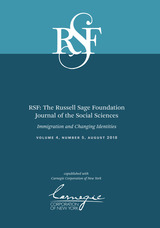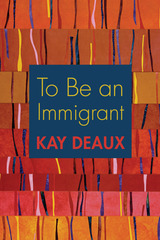2 books about Deaux, Kay

RSF
The Russell Sage Foundation Journal of the Social Sciences: Immigration and Changing Identities
Kay Deaux
Russell Sage Foundation, 2018
Since the 1960s, the United States has undergone a profound demographic transformation due to increased immigration from Asia, Latin America, the Caribbean, and elsewhere. Today immigrants and their U.S.-born children represent approximately 25 percent of the population, or more than 85 million people. How has immigration changed the way that both newcomers and the native-born understand what it means to be American? This issue of RSF, edited by immigration scholars Kay Deaux, Katharine Donato, and Nancy Foner investigates how immigration has shaped the way longer-established Americans, as well as immigrants and their children, see themelves and others in terms of race, ethnicity, and national identity --- and also considers the implications for intergroup relations.
Several articles explore how immigrants negotiate their positions in the racial hierarchy and how they perceive themselves in relation to native-born groups. Michael Jones-Correa and coauthors find that while Mexican immigrants are more likely to identify as Americans the more they report positive interactions with both native-born whites and blacks, Indian immigrants’ identification with being American is largely shaped by positive interactions just with whites. Prema Kurien shows that in response to the wave of hate crimes after 9/11, Sikh Americans sought to be recognized as an American religious minority, as well as an ethnic group distinct from Indian Americans. In their study of the children of immigrants in middle adulthood, Cynthia Feliciano and Rubén G. Rumbaut find that some second-generation immigrants retain a strong attachment to an ethnic identity into their late thirties, but that ethnic identification for others wanes as their social identities as parents, workers, or spouses become more important.
Other contributors investigate the extent to which longer-established Americans respond to increased immigration. Maureen Craig and Jennifer Richeson show that whites living in areas with large or increasing racial minority populations are more likely to believe that anti-white discrimination is on the rise. Deborah Schildkraut and Satia Morotta similarly find that when millennials—particularly those who identify as white and Republican—are exposed to information on the changing racial makeup of the U.S., they express more conservative political views.
At a time when questions of immigration and national identity are at the forefront of our political and public discourse, understanding how immigrants and their offspring influence—and are influenced by—conceptions of race and identity is critical for social scientists. This issue provides key insights into the challenges of a rapidly changing population.
Several articles explore how immigrants negotiate their positions in the racial hierarchy and how they perceive themselves in relation to native-born groups. Michael Jones-Correa and coauthors find that while Mexican immigrants are more likely to identify as Americans the more they report positive interactions with both native-born whites and blacks, Indian immigrants’ identification with being American is largely shaped by positive interactions just with whites. Prema Kurien shows that in response to the wave of hate crimes after 9/11, Sikh Americans sought to be recognized as an American religious minority, as well as an ethnic group distinct from Indian Americans. In their study of the children of immigrants in middle adulthood, Cynthia Feliciano and Rubén G. Rumbaut find that some second-generation immigrants retain a strong attachment to an ethnic identity into their late thirties, but that ethnic identification for others wanes as their social identities as parents, workers, or spouses become more important.
Other contributors investigate the extent to which longer-established Americans respond to increased immigration. Maureen Craig and Jennifer Richeson show that whites living in areas with large or increasing racial minority populations are more likely to believe that anti-white discrimination is on the rise. Deborah Schildkraut and Satia Morotta similarly find that when millennials—particularly those who identify as white and Republican—are exposed to information on the changing racial makeup of the U.S., they express more conservative political views.
At a time when questions of immigration and national identity are at the forefront of our political and public discourse, understanding how immigrants and their offspring influence—and are influenced by—conceptions of race and identity is critical for social scientists. This issue provides key insights into the challenges of a rapidly changing population.
[more]

To Be an Immigrant
Kay Deaux
Russell Sage Foundation, 2006
Immigration is often discussed in broad, statistical terms, with a focus on how it affects labor markets, schools, and social services. But at its most basic level, immigration is a process that affects people and their identities in deeply personal ways. In To Be an Immigrant, social psychologist Kay Deaux explores the role of both social conditions and individual capacities in determining how well immigrants adapt to life in their new homelands, and makes a strong case for the relevance of social psychology in immigration studies. To Be an Immigrant looks at how immigrants are defined, shaped, and challenged by the cultural environment they encounter in their new country and offers an integrated psychological framework for studying the immigrant experience. Deaux argues that in addition to looking at macro-level factors like public policies and social conditions and micro-level issues like individual choices, immigration scholars should also study influences that occur on an intermediate level, such as interpersonal encounters. Each of these three levels of analysis is essential to understanding how immigrants adapt to a new homeland and form distinct identities. As a case study for her framework, Deaux examines West Indians, exploring their perceptions of the stereotypes they face in the United States and their feelings of connection to their new home. Though race plays a limited role in the West Indies, it becomes more relevant to migrants once they arrive in the United States, where they are primarily identified by others as black, rather than Guyanese or Jamaican. Deaux's research adds to a growing literature in social psychology on stereotype threat, which suggests that negative stereotypes about one's group can hinder an individual's performance. She finds that immigrants who have been in the United States longer and identify themselves as African American suffer from the negative effects of stereotype threat more than recent immigrants. More than a discrete event, immigration can be understood as a life-long process that continues to affect people well after they have migrated. To Be an Immigrant takes a novel approach to the study of immigration, looking at how societal influences help shape immigrants and their understanding of who they are.
[more]
READERS
Browse our collection.
PUBLISHERS
See BiblioVault's publisher services.
STUDENT SERVICES
Files for college accessibility offices.
UChicago Accessibility Resources
home | accessibility | search | about | contact us
BiblioVault ® 2001 - 2024
The University of Chicago Press









